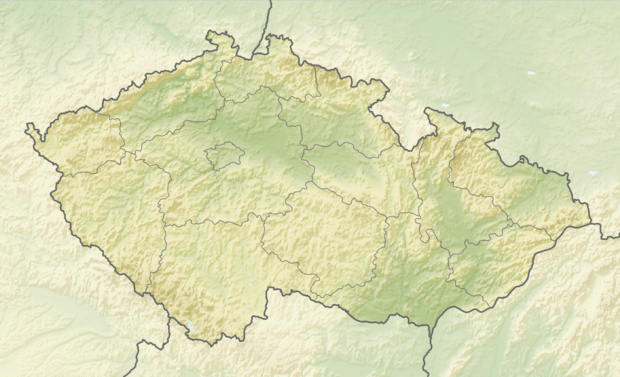Mirošov (Rokycany District)
Mirošov (German: Miröschau) is a town in the Plzeň Region of the Czech Republic. It has about 2,300 inhabitants.
Mirošov | |
|---|---|
Town | |
Mirošov Castle | |
 Flag  Coat of arms | |
 Mirošov Location in the Czech Republic | |
| Coordinates: 49°41′33″N 13°39′41″E | |
| Country | |
| Region | Plzeň |
| District | Rokycany |
| First mentioned | 1366 |
| Government | |
| • Mayor | Vlastimil Sýkora |
| Area | |
| • Total | 13.62 km2 (5.26 sq mi) |
| Elevation | 457 m (1,499 ft) |
| Population (2020-01-01[1]) | |
| • Total | 2,274 |
| • Density | 170/km2 (430/sq mi) |
| Time zone | UTC+1 (CET) |
| • Summer (DST) | UTC+2 (CEST) |
| Postal code | 338 43 |
| Website | www |
Geography
Mirošov lies 7 km southeast of Rokycany, 457 m above sea level. Mirošov is located on the Skořický potok Stream that is joined by Příkosický potok Stream in the town's territory. In the east large forested complex of Brdy hills begins, its highest elevations being Tok (864 m above sea-level) and Praha (862 m above sea-level). Brdy hills reach to the proximity of Mirošov with elevation of Záborčí (569 m above sea-level). 2 km southeast from Mirošov lies a settlement of Myť. This small village is under administration of Mirošov.
History
Mirošov was first mentioned in 1366, when Dobrohost of Ronšperk donated his estates in Mirošov to the Dominican Order Monastery in Plzeň. The village was for centuries dominated by various feudal families. However in 19th century the face of Mirošov and its environs profoundly changed with discovery of rich coal deposits. In 1833 mining started in the modest dimensions but the real impetus to industrial coal mining was given by 1857 when two individuals found mighty coal bed. Rapid development of coal mining industry followed. Several coal pits sprang up in and around Mirošov making this region one of the foremost coal producing localities in Bohemia. In 1871 growing Mirošov was proclaimed a market town ("městys"). As early as 1869 Mirošov had railway link to Rokycany which gave local coal access to markets in Central Europe. The railway served for cargo transport only creating an intricate network of sidings into local coal pits. Since 1879 public transport started on the Mirošov-Rokycany railway too. In 1882 another stretch of this railway opened, connecting Mirošov with Nezvěstice on the main Plzeň-České Budějovice railway artery. At the height of industrial prosperity Mirošov hosted 1,600 miners however with increased exploitation coal reserves were relatively soon depleted and by 1904 mining stopped in Mirošov. The town's population dropped and local economy reverted to its semi-rural shape. Some small-scale mining continued until 1947.
Internment Camp
After World War II Mirošov was the site of an internment camp for ethnic Germans. The (now deceased) commander of the camp, Frantisek Foukal, has been accused of killing 220 of the inmates through maltreatment and direct killings, of which there is photographic evidence for the latter.[2]
Demography
As to ethnicity, Mirošov, has traditionally been a Czech settlement. After cessation of coal mining at the end of 19th century the population dropped and has stagnated thereafter.
|
| |||||||||||||||||||||||||||
| Source: [3][4][5] | ||||||||||||||||||||||||||||
Notable people
- Karel Kašpar (1870–1941), catholic Archbishop of Prague
- Ladislav Karel Feierabend (1891–1969), agrarian politician, owned chateau of Mirošov in 1939–48 and lived here for some time
References
- "Population of Municipalities – 1 January 2020". Czech Statistical Office. 2020-04-30.
- Sudeten Germans demand punishment for Czech camp commandant Radio Praha 11-07-2000 Olga Szantová (accessed 2010-02-02)
- Vývoj počtu obyvatel správních obvodů a měst
- 1301-07, Počet obyvatel v obcích České republiky , obsah | ČSÚ
- http://www.czso.cz/xp/edicniplan.nsf/t/E4002BDBFB/$File/13-322603b01.xls Archived 2011-06-08 at the Wayback Machine